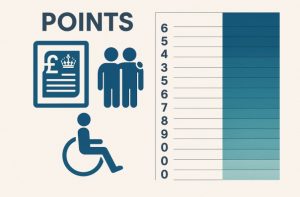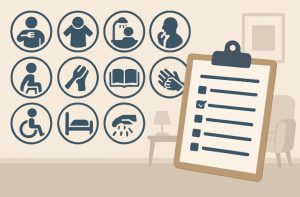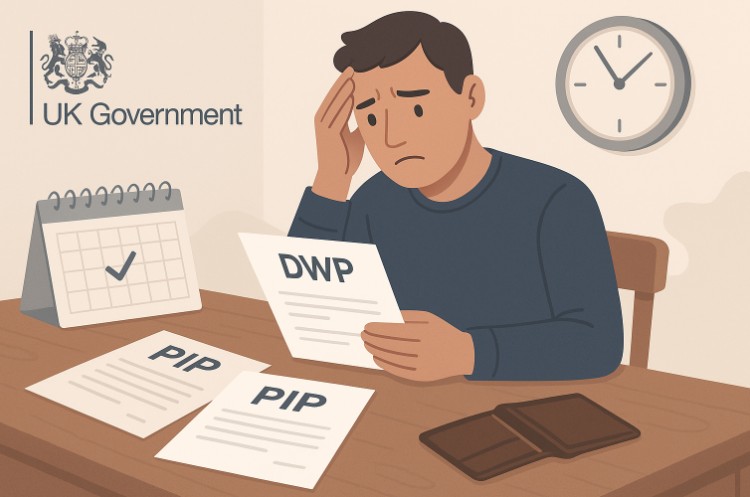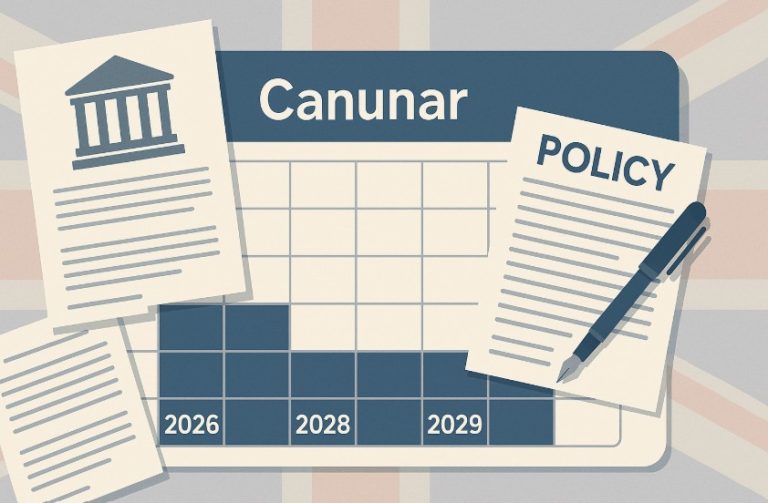Personal Independence Payment (PIP) is a vital financial support system designed to assist individuals in the UK who live with long-term health conditions or disabilities.
Administered by the Department for Work and Pensions (DWP), PIP replaces Disability Living Allowance (DLA) for people aged 16 or over and under State Pension age.
One of the most essential aspects of PIP is the points-based assessment system, which is used to determine eligibility and the level of financial support a claimant can receive. Many ask: what are the 12 points for PIP, and how do they impact a claim?
This guide will walk you through the 12 assessed activities, the scoring system, and how you can meet the criteria to qualify.
What Is PIP and Who Can Claim It?

Personal Independence Payment (PIP) is a UK benefit provided to individuals who live with long-term physical or mental health conditions that affect their ability to perform everyday tasks.
It is made up of two components: daily living and mobility. Each component can be paid at either a standard or enhanced rate, depending on how severely the condition impacts the claimant’s life.
To claim PIP, individuals must:
- Be aged between 16 and State Pension age
- Have a health condition or disability that has affected daily life for at least three months
- Expect the condition to continue for at least another nine months
- Be assessed to determine the impact of their condition on their functional ability
A key element of the assessment is the points system, which helps determine eligibility and award levels.
What Are the 12 PIP Activities Assessed During Evaluation?
There are 12 activities assessed for PIP. Ten of them relate to daily living, while two relate to mobility.
These activities reflect a range of physical, sensory, cognitive and mental health challenges that can make day-to-day life difficult.
The assessed activities are:
- Preparing food
- Taking nutrition
- Managing therapy or monitoring a health condition
- Washing and bathing
- Managing toilet needs or incontinence
- Dressing and undressing
- Communicating verbally
- Reading and understanding written information
- Engaging with other people face-to-face
- Making budgeting decisions
- Planning and following journeys
- Moving around
Each activity includes a list of descriptors, each with an associated point value.
How Does the PIP Points System Work?

The PIP points system is the foundation of how entitlement is assessed for both the daily living and mobility components.
Each of the 12 activities used in the assessment includes a list of descriptors that represent varying levels of difficulty.
These descriptors are each assigned a points value, usually ranging from 0 to 12, depending on the severity of the limitations.
When a person applies for PIP, they are evaluated on how their condition affects them most of the time, typically meaning more than 50% of days.
The assessor selects the descriptor within each activity that best reflects the claimant’s ability, and the associated points are recorded.
Each component daily living and mobility is scored separately. The total score for each determines not only whether the person qualifies, but also the rate they will receive.
Points Thresholds for PIP
To receive an award, the claimant must score:
- 8 to 11 points in a component to receive the standard rate
- 12 or more points in a component to receive the enhanced rate
If the score is fewer than 8 points, no award is given for that component.
Component Breakdown
- Daily Living Component includes 10 activities such as preparing food, managing therapy, and communicating verbally.
- Mobility Component includes 2 activities: planning and following journeys, and moving around.
Only one descriptor can be chosen for each activity—the one that most accurately describes the person’s difficulties. If multiple descriptors could apply, the highest scoring one is selected.
Important Notes
- You do not have to meet the criteria for every activity to qualify. Points from several different activities can be combined to reach the total.
- The descriptors reflect what you can do reliably, which means safely, repeatedly, in a reasonable time, and to an acceptable standard. If you cannot perform an activity reliably, you should be treated as being unable to do it.
- Fluctuating conditions are assessed based on how you are affected most of the time, not just on good days.
Example
If someone struggles with preparing food (4 points), taking nutrition (2 points), dressing (4 points), and managing toilet needs (2 points), they could score 12 points in daily living and therefore qualify for the enhanced rate for that component.
This structured points-based method is designed to ensure consistency, fairness, and transparency in how the DWP assesses and awards Personal Independence Payment. Understanding the system allows claimants to prepare detailed, relevant information that reflects the true impact of their condition.
How Many Points Do You Need to Qualify for PIP?
To qualify for Personal Independence Payment (PIP), a claimant must score enough points in one or both components of the assessment: daily living and mobility.
These points are awarded based on how a person’s condition affects their ability to perform a range of everyday tasks, as outlined in 12 specific activities.
Each activity contains a set of descriptors with associated point values, and only one descriptor per activity is chosen specifically, the one that best represents the level of difficulty experienced most of the time.
The number of points awarded across the relevant activities is then totalled to determine whether a person qualifies for PIP and, if so, at what rate.
Points Thresholds for Each PIP Component
| Component | Standard Rate | Enhanced Rate |
| Daily Living | 8 to 11 points | 12 or more points |
| Mobility | 8 to 11 points | 12 or more points |
A claimant who scores between 8 and 11 points in a component is awarded the standard rate for that component. If they score 12 or more points, they receive the enhanced rate. If fewer than 8 points are scored in a component, no award is given for that part of the benefit.
Scoring Example
Let’s consider a person with a chronic illness that limits both physical and cognitive abilities. They may be scored as follows in the daily living component:
- Preparing food: Needs assistance: 4 points
- Dressing and undressing: Needs help with upper body: 4 points
- Managing therapy: Requires assistance for more than 7 hours/week: 6 points
This individual’s total would be 14 points, which qualifies them for the enhanced rate of the daily living component.
In the mobility component, they may receive:
- Planning and following journeys – Needs prompting due to anxiety: 4 points
- Moving around – Can walk no more than 50 metres with aid: 10 points
The mobility total here is 14 points, again qualifying for the enhanced rate.
Partial Qualification
It is possible to qualify for one component but not the other. For example:
- A person who can manage most daily living tasks independently but cannot walk more than 20 metres may receive no award for daily living but qualify for enhanced mobility.
- Another person with significant cognitive impairments affecting daily routines but no physical mobility issues may receive enhanced daily living and no award for mobility.
Important Considerations
- The points awarded are based on how the condition affects the person more than 50% of the time.
- Each descriptor must apply reliably, meaning the activity must be performed safely, repeatedly, within a reasonable time, and to an acceptable standard.
- If an individual can technically complete a task but only with severe discomfort, risk, or excessive time, they may still be eligible for points.
- The total points are not cumulative across both components. Each is assessed independently, and eligibility is calculated separately for daily living and mobility.
Understanding how these point thresholds work gives claimants a clear view of what is required to meet PIP eligibility criteria and allows them to present their challenges clearly during the application and assessment process.
What Are the Daily Living Component Activities and Their Descriptors?

The daily living component measures a person’s ability to carry out tasks related to personal care and independence. The descriptors reflect increasing levels of need, from no assistance to requiring full support.
Below is a summary of the scoring structure for the ten daily living activities.
| Activity | Descriptor (example) | Points |
| Preparing food | Cannot prepare and cook food | 8 |
| Taking nutrition | Needs help to manage a therapeutic source | 6 |
| Managing therapy | Needs help managing therapy for more than 14 hours/week | 8 |
| Washing and bathing | Needs another person to wash entire body | 8 |
| Managing toilet needs | Needs assistance managing incontinence (bladder and bowel) | 8 |
| Dressing and undressing | Cannot dress or undress at all | 8 |
| Communicating verbally | Cannot understand or express verbal info with support | 12 |
| Reading information | Cannot read or understand written information | 8 |
| Engaging face-to-face | Cannot engage due to psychological distress | 8 |
| Making budgeting decisions | Cannot make any budgeting decisions | 6 |
Some individuals may score lower in several activities, but their total may still reach the qualifying threshold. Others may score high in fewer categories and still be eligible.
What Are the Mobility Component Activities and How Are They Scored?
The mobility component includes two activities: planning and following journeys, and moving around. These are designed to evaluate a person’s ability to travel safely and reliably.
Each activity is broken down into descriptors, which reflect increasing levels of difficulty and support.
| Activity | Descriptor (example) | Points |
| Planning and following journeys | Cannot follow route of familiar journey unaided | 12 |
| Moving around | Cannot move more than 1 metre | 12 |
Some individuals may experience mental health challenges that make it difficult to leave the house or follow a route, while others may have physical limitations that affect their ability to walk or stand.
A few examples of how points may be assigned:
- A claimant who cannot leave the house due to anxiety may receive 12 points under planning and following journeys
- A person who uses a wheelchair and cannot walk more than 1 metre may also receive 12 points under moving around
The final score determines whether the claimant receives no award, a standard award, or an enhanced mobility award.
How Is a PIP Assessment Carried Out?
The PIP assessment is conducted to understand how a person’s condition affects their daily life. This assessment is carried out by a health professional, either face-to-face, via telephone, or occasionally through a paper-based review.
The process includes:
- A review of the “How your disability affects you” form
- A discussion of how the condition impacts each of the 12 activities
- Review of medical and supporting evidence provided
- Observations made by the assessor during the appointment
Claimants are encouraged to describe the challenges they face on a typical day. It’s important to talk about difficulties even if they seem minor, as they can influence the overall score.
What Tips Can Help You Score Higher on a PIP Application?

When completing a PIP claim form or attending an assessment, clarity and detail are essential. The information provided should accurately reflect the difficulties faced on a daily basis.
A few useful tips include:
- Describe specific examples of how tasks are affected
- Be honest about bad days and how often they occur
- Explain any pain, fatigue or confusion involved in completing tasks
- Mention if assistance, aids or prompting are needed
- Submit medical evidence where possible, including letters from professionals
It’s also helpful to use wording similar to the descriptors used in the official assessment guidance.
How Can You Appeal a PIP Decision If You Disagree?
If a PIP application is unsuccessful or the awarded rate is lower than expected, claimants can challenge the decision. This process includes several steps:
- Request a Mandatory Reconsideration from the DWP within one month of the decision. This involves reviewing the claim again, possibly with additional evidence.
- If the decision remains unchanged, claimants can appeal to an independent First-tier Tribunal.
- The tribunal will examine the case in detail and decide whether the original decision was correct.
Appeals often result in awards being increased, especially when detailed evidence is presented. Many individuals find it helpful to seek advice from welfare rights advisers or legal aid services when pursuing an appeal.
What Changes in 2025 Might Affect Your PIP Claim?
In 2025, several policy updates and procedural improvements may impact how PIP claims are assessed and awarded. Some potential changes under consideration include:
- Increased use of digital tools for assessments
- Adjustments to how mental health conditions are scored
- Enhanced processes for supporting claimants with fluctuating conditions
Keeping informed through trusted benefit advice organisations and the GOV.UK website ensures claimants stay up to date with changes that might affect their eligibility or reassessment process.
Conclusion
Understanding how the PIP points system works is essential for anyone applying for support due to a long-term health condition or disability.
Knowing the 12 assessed activities and how points are awarded helps applicants better prepare for the process and provide accurate information.
Whether applying for the first time or requesting a reassessment, focusing on how your condition affects you daily can make a significant difference. Accurate, honest details and supporting evidence remain key to a successful PIP claim.
Frequently Asked Questions About 12 Points for PIP
What is the maximum PIP payment per week?
PIP payments range based on your score. As of 2025, the enhanced daily living rate is £108.55 per week, and the enhanced mobility rate is £75.75 per week.
Can mental health conditions qualify for PIP?
Yes, conditions like depression, anxiety, PTSD, and others can qualify if they significantly impact daily living or mobility tasks.
Do I need a diagnosis to claim PIP?
While a formal diagnosis is helpful, it is not strictly required. What matters is how your condition affects your daily life.
Can I work and still receive PIP?
Yes, PIP is not means-tested. You can work and still be eligible as long as your condition impacts daily activities.
How long does a PIP decision take?
It typically takes 3 to 4 months from application to decision, though this can vary.
Will I need to be reassessed?
Most PIP awards are for a fixed period (e.g., 2 or 3 years), after which a reassessment may be required.
Can I get help completing the PIP form?
Yes, you can get help from Citizens Advice, disability charities, or welfare rights organisations.






